This extraordinary spot is an Aussie campsite like no other
By Andrew Bain
In the minutes before dawn, a safari-style vehicle rolls across the top of a desert ridge, towing a plume of red dust behind. The salt sheet of Lake Frome is laid out to the east, looking like a bank of cloud from which the sun will soon rise. Except that in customary outback fashion, there’s not an actual cloud in sight.
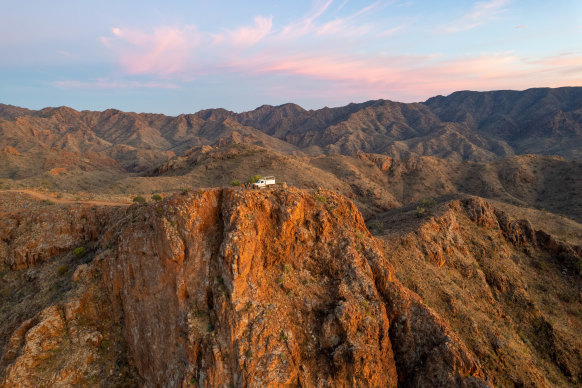
Riding the ridge.
As we head across this ridge, we’re driving along one of the most famous sights in the South Australian outback, but we’re here at the most uncommon of times. Tour vehicles have been travelling over Arkaroola’s Ridgetop Track since it was built by a uranium exploration company in the late 1960s, but only recently has it become possible to sleep out along the way.
Launched last winter, the Ridgetop Sleepout is no ordinary camp. Atop this ridge framed by mountains, four timber and corrugated-iron platforms have been constructed among the grass trees and spinifex. Each platform is laid out with a swag and hangs from the ridge like a balcony, providing views across the surrounding domes and saw-toothed peaks. It’s the full Ridgetop Track scene condensed, but with sunset, sunrise, steak and wine thrown in.
The privately owned Arkaroola Wilderness Sanctuary is laced with more than 100 kilometres of 4WD tracks, which were built almost entirely by uranium companies, though the land yielded just enough ore to keep them interested for the time it took to build the roads. All of them are open to the public, except this one treasured track with its notoriously steep grades and cliff-edged design.
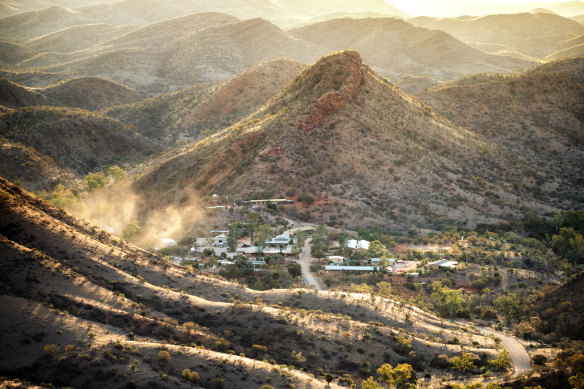
Arkaroola Village seen from Acacia Ridge.
At a locked gate in a valley outside of Arkaroola’s village, we enter this private and rugged realm. In the most outback of ways, our guide, driver, chef and wine pourer is named Macca, and immediately the track rears steeply up the slopes. As it climbs to Coulthard’s Lookout, it feels as precipitous as any rickety mountain track, though Macca drives as calmly as if it was a school zone. In the back of the vehicle, with its canvas roof and open sides, we look every bit like we’re here to see giraffes and lions.
Coulthard’s is one of three lookouts along the track, though there’s never not a view, nor some fascinating historical snippet. Just beyond the lookout is Radium Ridge, where the namesake radioactive metal was discovered by William Greenwood in 1910 (and later where Americans came searching for the uranium to arm Oppenheimer’s atomic bomb).
When Greenwood took his finds to Adelaide for identification, it was famed Antarctic expedition leader and geologist Sir Douglas Mawson who examined them, beginning a lifelong connection to this place in the northern Flinders Ranges – Mawson spent far more time in Arkaroola than Antarctica.
Working under Mawson in the late 1930s was a young geology student, Reg Sprigg. Mawson told Sprigg that he’d seen no place like Arkaroola anywhere in the world, and it needed to be protected. Thirty years later, Sprigg bought the land, creating the Arkaroola Wilderness Sanctuary. Today his son Doug, who was named after Mawson, continues to run the sanctuary with its motel-style accommodation, campground, bar, restaurant and tours.
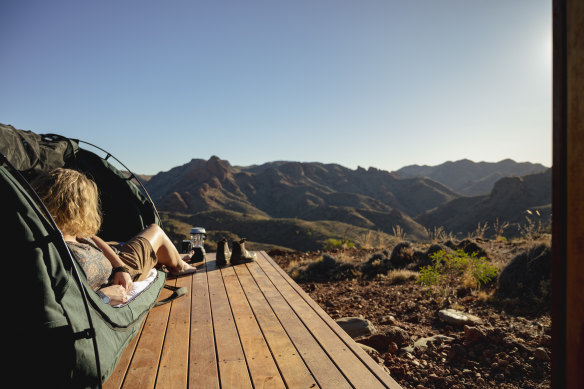
Room with a view – one of the sleepout platforms and its canvas cover.
From Radium Ridge, the track continues to squiggle through the mountains as it skirts Mount Painter and Mount Gee, two peaks at the heart of Arkaroola’s claim to geological greatness. With its rocks textured like popcorn and its slopes honeycombed with caves and tunnels, Mount Painter was once a bubbling mud lake, while adjoining Mount Gee was a geyser. Unlike similar features elsewhere, they weren’t created by volcanic thermal activity, but by the fierce heat of uranium.
The steepest moments on the Ridgetop Track come on the final approach to camp as it plunges into a valley then ramps up onto Streitberg Ridge, its open top dotted with the glamping-style platforms.
The platforms are spaced 50 to 100 metres apart to create a sense of outback solitude, and at the heart of the camp is an open-air kitchen from which Macca is quickly preparing dinner. A fire-pit warms the cooling desert evening, and dinner will be eaten on a hand-built red-gum table, its legs made from the broken leaf springs of Ridgetop Track tour vehicles.
Across the valleys, the most prominent part of the view is a stark, bald, line of domes known as the Armchair, a place of particular significance to another Arkaroola guide, Sharpy Coulthard. It was beneath these peaks that the Adnyamathanha man’s grandfather was born.
Many years later, in 1995, Sharpy walked into Arkaroola Village, on his traditional lands, with a written proposal to run tours in the sanctuary. Almost 30 years on, he continues to do so. One morning before setting out on the Ridgetop Track, I join him on a walk into Mawson Valley, stretching out behind Arkaroola Village.
The day is unseasonably cold, and Coulthard walks ahead of me in UGG boots, pointing out the bush foods that stocks this seemingly bare valley – the acacia seeds that continue to be ground up for flour, and the native pears that flower beside us.
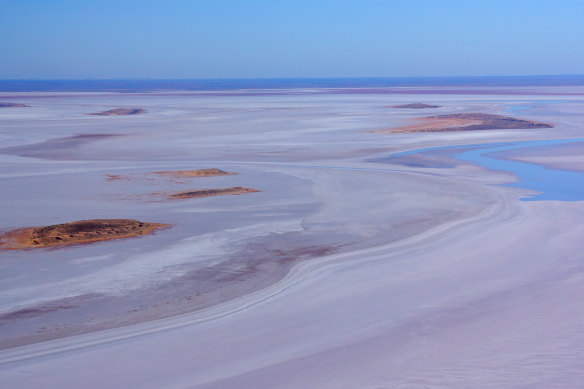
Lake Frome, looking like a cloud.
“It looks dry and dusty, but there’s a lot out here,” he said. “Our people were lucky because we had two types of country. They could go out to Lake Frome to forage and then come to the mountains here.”
At an outcrop of rocks known as Sitting Bull, two kilometres up the valley, we stop. Wedge-tailed eagles soar on the currents overhead, and a pair of yellow-footed wallabies bound hurriedly past as Coulthard recounts the creation story of Arkaroo, the serpent who drank Lake Frome dry. Today the lake’s salty surface is one of the brightest spots on Earth, used by NASA to calibrate satellites, much like a camera sets a white balance.
Back in camp on Streitberg Ridge, eye fillets are cooking on the coals as the mountains begin to glow in the day’s last rays of light. In the morning we’ll make the final 15-minute drive to Sillers Lookout, the Ridgetop Track’s showstopping end, standing high above Lake Frome, with the lights of Beverley uranium mine like distant fireflies. For now, however, all the lights we can see are overhead.
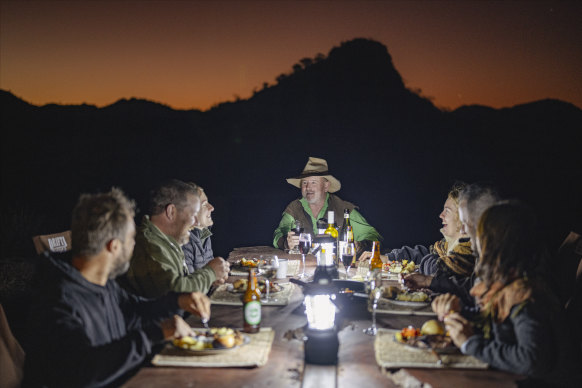
Dinner at the camp.
In July 2023, Arkaroola became South Australia’s first International Dark Sky Sanctuary, and only the second in Australia, recognising it as one of the best places on the planet to observe the night sky. It’s a detail that’s hard to miss on a visit.
Arkaroola has three observatories, with more than half-a-dozen telescopes that can be trained on the night sky. Just steps from the reception and restaurant, the newest observatory was built in 2019 at a cost of about $200,000, feeding live shots of remarkable clarity to a nightly big-screen presentation by astronomer Alex Hine.
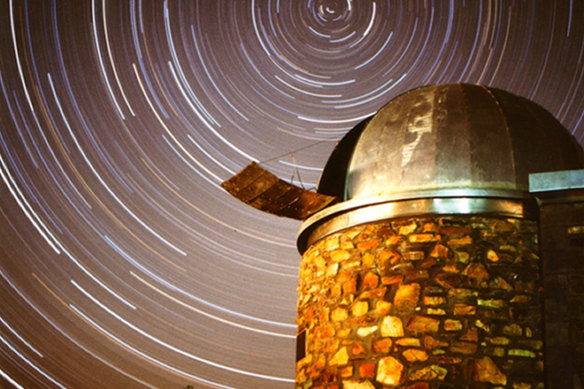
Arkaroola and its night sky.
On Streitberg Ridge, there’s another telescope for sleepout campers, though this night is too windy for it to provide stable viewing. Instead, we sit long into the night around the fire, its embers spitting like shooting stars.
Eventually I wander away through the darkness to bed. On my platform, I roll back the cover of the swag, letting in the outback night-light of moon and stars. It’s almost too bright to sleep, but it’s perfect.
THE DETAILS
Ridgetop Sleepout tours depart on Sundays and Wednesdays, operating as two-night (from $985) or three-night (from $1260) packages, including accommodation at the village. Arkaroola Wilderness Sanctuary is 640 kilometres north of Adelaide, with accommodation and meals at Arkaroola Village. See arkaroola.com.au/ridgetop-sleepout-decks
The writer travelled courtesy of the South Australian Tourism Commission. See southaustralia.com
Sign up for the Traveller Deals newsletter
Get exclusive travel deals delivered straight to your inbox. Sign up now.